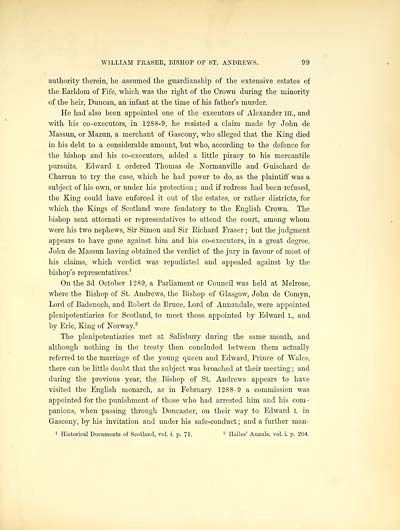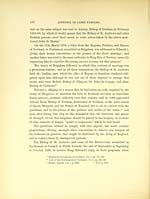Frasers of Philorth > Volume 2
(113)
Download files
Complete book:
Individual page:
Thumbnail gallery: Grid view | List view

WILLIAM ERASER, BISHOP OF ST. ANDREWS. 99
authority therein, he assumed the guardianship of the extensive estates of
the Earldom of Fife, which was the right of the Crown during the minority
of the heir, Duncan, an infant at the time of his father's murder.
He had also been appointed one of the executors of Alexander in., and
with his co-executors, in 1288-9, he resisted a claim made by John de
Massun, or Mazun, a merchant of Gascony, who alleged that the King died
in his debt to a considerable amount, but who, according to the defence for
the bishop and his co-executors, added a little piracy to his mercantile
pursuits. Edward I. ordered Thomas de Normanville and Guischard de
Charrun to try the case, which he had power to do, as the plaintiff was a
subject of his own, or under his protection ; and if redress had been refused,
the King could have enforced it out of the estates, or rather districts, for
which the Kings of Scotland were feudatory to the English Crown. The
bishop sent attornati or representatives to attend the court, among whom
were his two nephews, Sir Simon and Sir Eichard Fraser ; but the judgment
appears to have gone against him and his co-executors, in a great degree,
John de Massun having obtained the verdict of the jury in favour of most of
his claims, which verdict was repudiated and appealed against by the
bishop's representatives. 1
On the 3d October 1289, a Parliament or Council was held at Melrose,
where the Bishop of St. Andrews, the Bishop of Glasgow, John de Comyn,
Lord of Badenoch, and Eobert de Bruce, Lord of ADnandale, were appointed
plenipotentiaries for Scotland, to meet those appointed by Edward I., and
by Eric, King of Norway. 2
The plenipotentiaries met at Salisbury during the same month, and
although nothing in the treaty then concluded between them actually
referred to the marriage of the young queen and Edward, Prince of Wales,
there can be little doubt that the subject was broached at their meeting ; and
during the previous year, the Bishop of St. Andrews appears to have
visited the English monarch, as in February 1288-9 a commission was
appointed for the punishment of those who had arrested him and his com-
panions, when passing through Doncaster, on their way to Edward I. in
Gascony, by his invitation and under his safe-conduct ; and a further man-
1 Historical Documents of Scotland, vol. i. p. 71. 2 Hailes' Annals, vol. i. p. 204.
authority therein, he assumed the guardianship of the extensive estates of
the Earldom of Fife, which was the right of the Crown during the minority
of the heir, Duncan, an infant at the time of his father's murder.
He had also been appointed one of the executors of Alexander in., and
with his co-executors, in 1288-9, he resisted a claim made by John de
Massun, or Mazun, a merchant of Gascony, who alleged that the King died
in his debt to a considerable amount, but who, according to the defence for
the bishop and his co-executors, added a little piracy to his mercantile
pursuits. Edward I. ordered Thomas de Normanville and Guischard de
Charrun to try the case, which he had power to do, as the plaintiff was a
subject of his own, or under his protection ; and if redress had been refused,
the King could have enforced it out of the estates, or rather districts, for
which the Kings of Scotland were feudatory to the English Crown. The
bishop sent attornati or representatives to attend the court, among whom
were his two nephews, Sir Simon and Sir Eichard Fraser ; but the judgment
appears to have gone against him and his co-executors, in a great degree,
John de Massun having obtained the verdict of the jury in favour of most of
his claims, which verdict was repudiated and appealed against by the
bishop's representatives. 1
On the 3d October 1289, a Parliament or Council was held at Melrose,
where the Bishop of St. Andrews, the Bishop of Glasgow, John de Comyn,
Lord of Badenoch, and Eobert de Bruce, Lord of ADnandale, were appointed
plenipotentiaries for Scotland, to meet those appointed by Edward I., and
by Eric, King of Norway. 2
The plenipotentiaries met at Salisbury during the same month, and
although nothing in the treaty then concluded between them actually
referred to the marriage of the young queen and Edward, Prince of Wales,
there can be little doubt that the subject was broached at their meeting ; and
during the previous year, the Bishop of St. Andrews appears to have
visited the English monarch, as in February 1288-9 a commission was
appointed for the punishment of those who had arrested him and his com-
panions, when passing through Doncaster, on their way to Edward I. in
Gascony, by his invitation and under his safe-conduct ; and a further man-
1 Historical Documents of Scotland, vol. i. p. 71. 2 Hailes' Annals, vol. i. p. 204.
Set display mode to:
![]() Universal Viewer |
Universal Viewer | ![]() Mirador |
Large image | Transcription
Mirador |
Large image | Transcription
Images and transcriptions on this page, including medium image downloads, may be used under the Creative Commons Attribution 4.0 International Licence unless otherwise stated. ![]()
| Histories of Scottish families > Frasers of Philorth > Volume 2 > (113) |
|---|
| Permanent URL | https://digital.nls.uk/96571612 |
|---|
| Attribution and copyright: |
|
|---|---|
| Description | A selection of almost 400 printed items relating to the history of Scottish families, mostly dating from the 19th and early 20th centuries. Includes memoirs, genealogies and clan histories, with a few produced by emigrant families. The earliest family history goes back to AD 916. |
|---|

